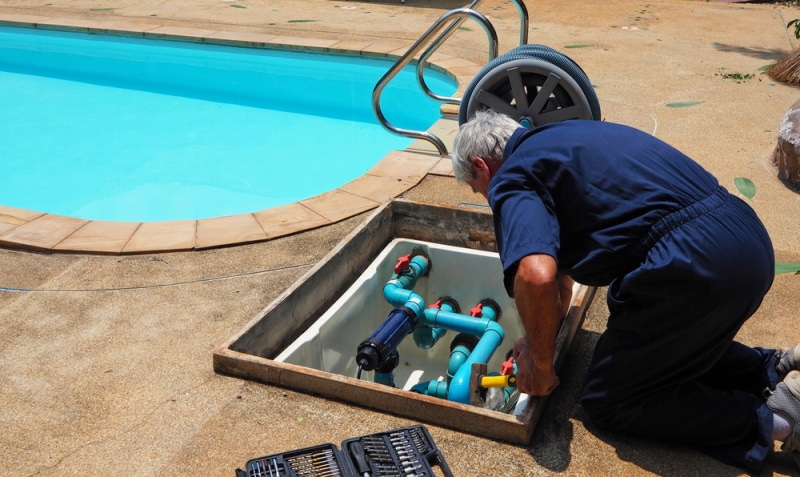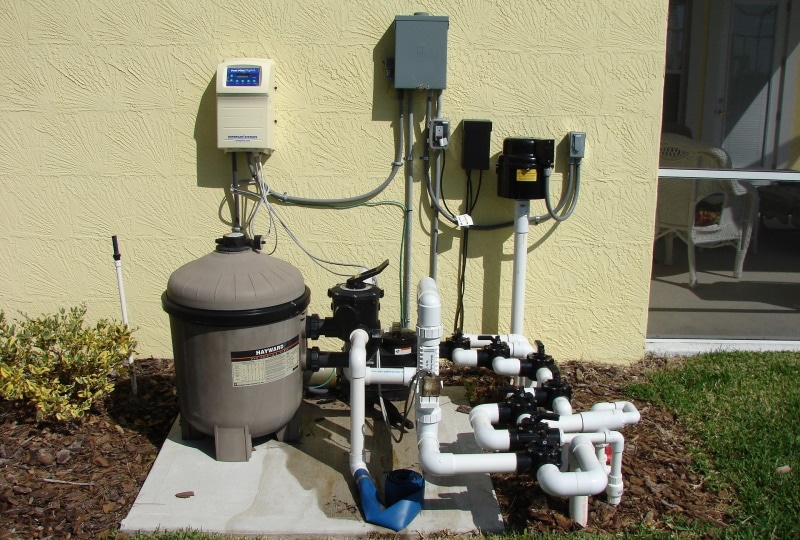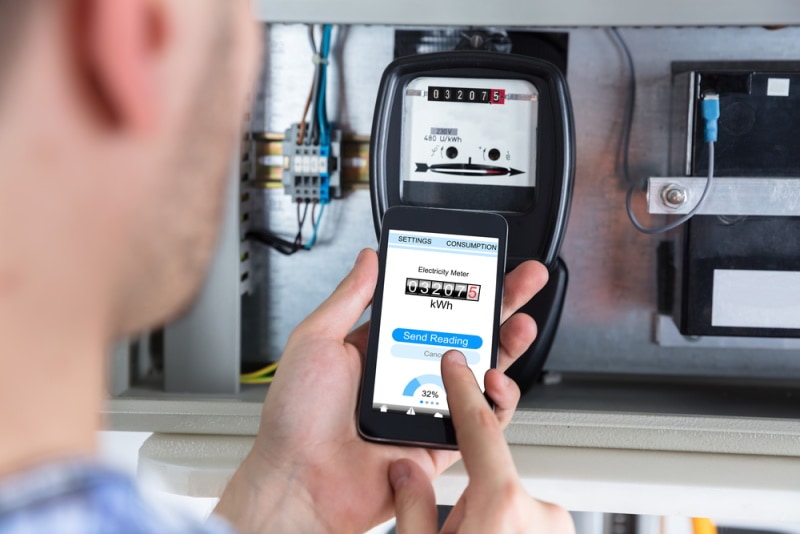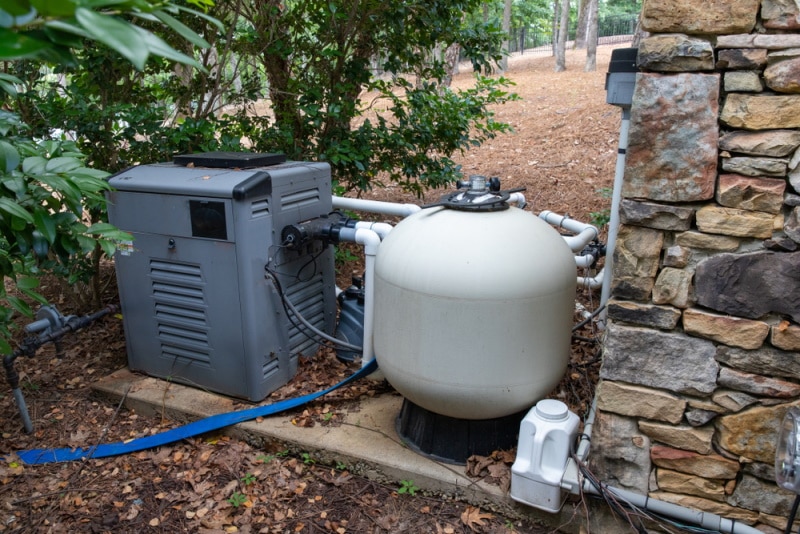How Much Electricity Does a Pool Pump Use? Types, Tips, & FAQ
-
Pete Ortiz
- Last updated:

If you compare the annual energy costs of a pool pump heater against that of a gas-fired pool heater, you’ll find that pool heat pumps are more energy-efficient. They consume up to 2,500 kWh per year to filter and circulate the pool water, making it one of the highest power consumers in a house.
While the figures above are just estimated costs, several factors determine the actual amount of energy a pool pump uses. For instance, a smaller pool pump should use less power than a bigger one. The best way to obtain the exact energy a pool pump consumes is to use a monthly heating cost calculator.
Hang around as we take you through the different factors that determine pool pump energy consumption and how to calculate your energy bill.
Pool Pump Running Costs
The national average energy rate¹ of a heat pump in the US stands at 11.8 cents per kWh. By multiplying with a yearly consumption of 2,500 KWh, we can estimate that energy costs due to pool pumps alone can mount up to around $300 per year.
If we assume the peak electricity tariff charges 30 cents on an hourly basis, the electricity cost required to run an average pool pump should range between 22.5–45 cents per hour. However, these costs may vary at night since off-peak power commonly starts after 10 p.m. in most areas.
Fortunately, you can offset high energy bills by installing solar panels that add energy value to your home. If you opt for the latest ECO multi-speed heat pumps, you can save hundreds every year.

Pool Pump Monthly Hourly Running Costs
| Pool Volume (Kiloliters) | Flow Rate in Liters per Minute (L/M) | Annual Average Watts Used | Summer Electricity Bill (If Used 6 hours Per Day) |
| 34–55 KL | 100–150 | 513 | $69.30 |
| 55–72 KL | 150–200 | 573 | $77.40 |
| 72–90 KL | 200–250 | 738 | $99 |
| 90–108 KL | 250–300 | 906 | $121.50 |
| More than 108 KL | Above 300 | 1,605 | $216 |
Pool Pump Hourly Running Costs
By approximation, running a pool pump for six hours per day adds an estimated $313.90 to your annual electricity bill. The following table shows the energy consumption rates as tabulated by Canstar Blue¹:
| Pool Volume (Kiloliters) | Liters per minute (Flow Rate) | Consumption per 1 hour | Consumption per 4 hours | Consumption per 6 hours |
| 35–55 KL | 513 | $0.13 | $0.51 | $0.78 |
| 55–72 KL | 573 | $0.14 | $0.57 | $0.86 |
| 72–90 KL | 738 | $0.18 | $0.75 | $1.10 |
| 90–108 KL | 908 | $0.23 | $0.90 | $1.35 |
| More than 108 KL | 1605 | $0.40 | $1.60 | $2.40 |
Calculating Pool Pump Costs
On your pump motor, you will notice a nameplate with voltage and current readings. These are the only readings you will need to find your monthly energy costs. Most pumps are written 115/230 next to volts and 14.6/7.3 next to amps.
Because power consumption is expressed in terms of wattage, you should first find the total watts by multiplying the voltage by the current. In our case, 115 volts x 14.6 amps = 1679 watts. Power is often expressed in kilowatts, so you need to divide the value by 1,000. That gives you 1.679 kW. Meanwhile, the billing is charged in kilowatt-hours (kWh).
As such, your next step is to multiply the power consumption by the total number of hours your pump runs in a month. If you use it for 6 hours every day, it means the total monthly costs are calculated as 1.679 kW x 180 hours = 302.22 kWh. The last step is to multiply the value by the utility charges, which are often 0.118 cents per kWh (i.e. 302.22 x 0.118 = 35.66). This means your monthly energy accumulated by running a pool pump alone is $35.66.

Is It Cheaper to Run a Pool Pump at Night?
The cost of running a pool pump at night can only be cheaper if it is connected to a time-of-use power line¹. In this case, the energy rate is significantly lower at night and higher during the day.
However, if the pool pump is connected to a controlled load tariff, the power rates will remain constant throughout the year. It is important to check with your local power distributor because the type of controlled tariff may vary from one state to another.
How to Reduce the Running Costs of a Pool Pump
Reducing the number of amps that a pool equipment pad consumes significantly reduces the monthly running costs. Here are a few useful tips to help you:
1. Run the Pump for Fewer Hours
If you are too skimpy with energy usage, you’ll need to be careful because the energy costs will significantly rise. Experiment with how much time it takes to keep your pool clean and clear in any season of the year. In most cases, summers require double the time it takes during colder seasons to filter a pool.
If the pool has undersized systems, it will run the pump longer than pools with larger systems because the flow rates are higher and the filters are more effective. Most pool pumps are designed to complete the filtering process within 8 hours, while others take up to 16 hours.
Some Sunbelt models have more advanced systems and take only 4 hours to turn over all the water in a pool during the off-season. After all, the shorter time a pool pump takes, the less power it consumes.
2. Install a Variable Speed Pump
Variable speed pumps¹ reduce the impeller speed (RPM) by half, meaning they consume less energy while using lower speeds. By installing one, you significantly reduce the required amperage by 8 times.
Another benefit of using such speed pumps is the quality of their motors. They are both quiet and durable. They are typically more durable than traditional induction motors, so you don’t have to worry about replacing them after a while.

3. Install a Bigger Filter
The role of a pump filter is to trap dirt. If it can trap the dirt in as little time as possible, the pool pump will take less time to run and, consequently, will use less power. That’s why you need to install a bigger and more effective filter.
Final Thoughts
Pool pumps are among the biggest energy drainers in any home. For this reason, it is essential to understand their running costs before installing them in your swimming pool.
Most of these devices consume up to 2,500 kWh per year. While the average cost of power per unit is 11.83 cents in the US, it translates to a monthly recurring cost of approximately $35.6. However, energy consumption may vary depending on the pump size, pool size, and its energy-efficiency.
Featured Image Credit: B Ledger, Shutterstock
Contents



